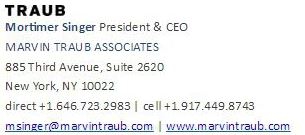TRAUB & Threadstone invite you to the First T.TALK |Thursday, Feb 2nd, NYC
"WHICH FASHION HOUSES HAVE THE 'HOTTEST' BRANDS?"
Discussion led by the founders of the Worldwide Barometer Exclusivity & Desirabil| ity of Luxury Brands Index

Luca Solca, Head of luxury goods research of financial services firm Exane BNP Paribas. Luca is the #1 ranked analyst for luxury coverage.
&

Philippe Jourdan, Partner at Promise Consulting, the premier luxury marketing research firm in Europe focused on measuring brand equity.
Thursday, February 2nd, 2017, 6:30 PM
Le Skyroom | 22 E 60th Street, NY 10022
PLEASE RSVP TO ahafkin@marvintraub.com by January 27th
Space is limited so a prompt RSVP is appreciated.
